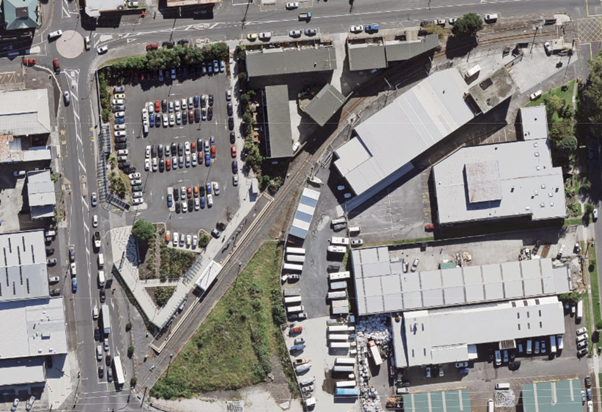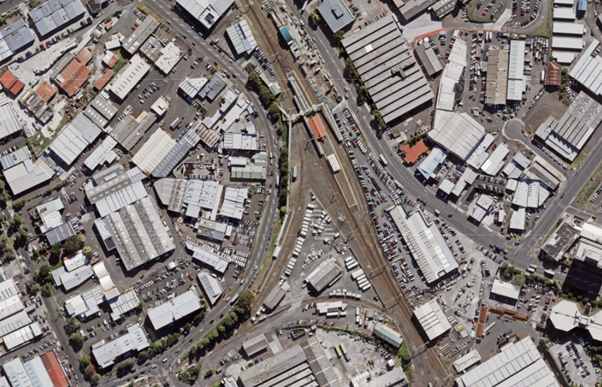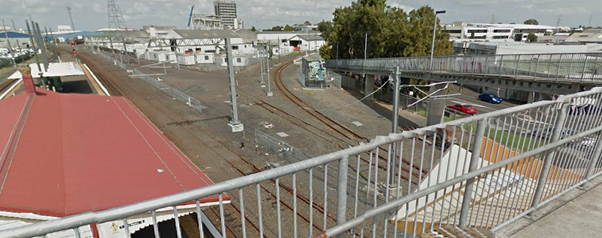A shuttle for the Onehunga Branch Line?
Thu, May 13, 2021 | Public Transport | Rapid TransitThe Onehunga branch was Auckland’s first railway line, running from the port of Onehunga on the Manukau harbour to the port of Auckland on the Waitemata. Despite being primarily a freight link for steamers coming up the west coast and the Waikato river, it had a long history of carrying people until the last passenger service ran in 1973.
It was reopened in 2010 as part of Project DART, following a package of work driven by Auckland Regional Council chairman Mike Lee and supported by a grassroots campaign by the Campaign for Better Transport.
The branch was reopened for passengers very cheaply, a mere $21m with half going on trackwork and half going on buying land at the Onehunga terminus and building two new stations and a third platform where the branch joins the mainline at Penrose Station. Just ten years later these costs seem stupendously small.
But there is a reason for this, the project was a no-frills job that did little to change the old single track freight branch other that make it functional. Its an example of how you can get things done quickly easily if you don’t load up the brief, but unfortunately that does mean the Onehunga Branch is severely limited looking into the future.
Limitations of the Onehunga Branch
In its current form the branch line can only accommodate half-sized trains running at best once every half hour, while every other station in Auckland can handle six-carriage trains every ten minutes at least.

The main things holding back better services on the branch are:
- Single track line. There’s only one track, which means only one train at a time on the whole length of the branch. Each train has to run all the way from the main line through the Penrose third platform, Te Papapa and Onehunga stations then turn around and come back the same way again, before the next train can enter the branch. This is the main reason why they can’t run more than 30-minute headways.
- Single track ‘wrong way’ junction. The junction is very basic. The Onehunga track comes off the northbound mainline track all the way up by the Great South Road overbridge. This means that outbound trains heading to Onehunga have to cross over and go the wrong way on the mainline for a couple hundred metres to get to the branch. This isn’t a problem itself but it does require blocking the southern line in both directions to give the Onehunga the green signal through. This is an issue with reliability and makes running more frequency difficult.
- Single track terminus. Only one track at the terminus means only one train at a time can stop there. Sounds obvious, but it means you can't have a schedule where a second train arrives before the first has left, which makes it more or less impossible to do timekeeping/layover stops at the terminus at any kind of frequency.
- Level crossings. The 3.6km long branch has eight level crossings, one every 4 or 500m on average. Increasing train frequency would mean the barrier arms go down more often, which means more delays for pedestrians and road traffic. But that could also delay trains, as once the arms go back up, they have to stay up for a reasonable amount of time to let people and cars cross the tracks safety. This makes doing anything clever with single track scheduling difficult.
- Short platforms and tight curves. The platforms are only long enough for three-car trains, and the one at Onehunga can’t be lengthened because it sits hard up against a tight curve lined with apartment buildings.
- Third platform at Penrose. The branch line platform at Penrose is located quite far away from the main Penrose station, and connecting to trains on the southern line requires a 250m walk up and over the switchback footbridges.
So to summarise, Onehunga is stuck with what it has. The single-track line limits the branch to infrequent headways, and the single-track terminus and the junction at Penrose would still limit the frequency and reliability even if you could run more trains through the middle. The level crossings could become a problem if you did find a way to do more frequency, while the constrained platforms mean only short trains can stop there.
What are the opportunities and limitations for improvements?
The airport rail and CRL projects have looked at options for fixing these issues, but the main problem is to run “normal” frequencies and trains requires masses of work to fix all the problems at the same time. To run six-car trains to Onehunga (or the airport or another extension) would require a new Junction at Penrose, rebuilding Penrose and Te Papapa stations, double tracking the whole route, removing the level crossings and relocating and rebuilding Onehunga station. In effect, it could need a billion-dollar elevated rail viaduct and junction, or an even more expensive trench to bring it up to scratch.
This is obviously a hard thing to justify for two stations that currently generate one to two thousand trips per day at best. But a bigger conundrum comes when you want to run Onehunga as part of an integrated network, especially once the CRL is open. The CRL tunnel works as the central core of a through-routed network. If all the other branches of network are running six, eight or more trains an hour, how exactly do you handle one branch that can only manage two trains an hour? What do you have to do to an otherwise efficient and legible train plan to fit that in? And can you still justify the potential reliability issues of the awkward junction to get them on and off the mainline, when they could delay Southern Line trains carrying a thousand people each at peak?
Then there are the short platforms. The two stations that are only served by the Onehunga Branch probably won’t ever need six car trains themselves as there’s enough capacity in the three-car units (especially if you could find more frequency at peak time). But what happens once those trains continue past Penrose onto the southern line and through the CRL? Can you justify using up the peak slots in the CRL for the little branch line trains, when they could be used for full sized trains on the main lines instead?

There are a range of solutions that have popped up for running the Onehunga Branch with the future CRL rail network. One is to split one of the main lines at Penrose to run two trains an hour to Onehunga and the other six or so to somewhere else like Otahuhu. Another idea is to run those two short Onehunga trains an hour across town to Henderson, avoiding the CRL entirely. A third is to simply keep running the Onehunga line into Britomart to terminate there as it does today, while the other lines carry on through the CRL.
These are all technically viable options, but none of them actually provide any better service frequency or longer trains for Onehunga, and in some cases make connectivity worse. They’re sort of ‘damage control’ concepts, acknowledging that Onehunga branch line services won’t ever get better but at least trying to stop them making the rest of the network worse. Nonetheless, they all still end up running odd twice-an-hour services with short trains on the main line. This means still running these ‘low value’ services through multiple congested junctions and stations, taking up resources and space that might be better used for other trains.
The shuttle option
There is one other option, to run the Onehunga branch as a shuttle. I think this actually solves a lot of the problems and could be the basis for getting better service quality for Onehunga passengers without a lot of cost.
Under a shuttle arrangement the Onehunga line would effectively become its own separate short train network. Trains would simply run the 3.6km route back and forth between Onehunga and Penrose only, taking six or seven minutes each way plus turnaround time at each end. This immediately deals with a couple of the issues. The trains would not pass through the Penrose junction at all, making the southern line work more efficiently. They wouldn’t run onto the main line at all, so they wouldn’t up space on the network, making the use of three-car trains a non-issue. The very short shuttle service would also be more reliable, itself no longer being exposed to delays at various stations and junctions along the line. This should reduce the time required for timekeeping stops at the terminus.
It would also make the service delivery much more efficient. Right now, running the Onehunga trains to Britomart takes two or three trains in service simultaneously (depending on the time of day and the stopping pattern) to keep the half hourly timetable. A short shuttle could do the same headway with only one train and crew in service. But perhaps more importantly, those existing two or three trains could run the branch every ten or fifteen minutes, doubling or tripling the capacity and slashing the wait time.
The downside of a shuttle course is that practically everyone from Onehunga would need to transfer at Penrose to get where they want to go. But that doesn’t have to be a downside if you can address the two things that can make transfers a hassle: the waiting time between connections, and the quality/convenience of the transfer environment. For the wait time, that is a factor of the service frequency of both the routes you are transferring between. Once the CRL is operational, or even before then, the main line side of the equation should be fine. With the southern line and probably also the western line running through Penrose Station there should be a train every five minutes or so each way at pretty much any time of day.
To me the question is: if we start from the assumption of separate shuttle service pattern for the Onehunga branch, does that let us significantly improve the frequency without breaking the bank, and what would we need to do at Penrose to make the transfer work well enough?
The following diagrams show the Auckland rail network with the width of the Onehunga line in proportion to the service frequency. The first one shows it as it is today, and the second what it could be with a shuttle.


What might an Onehunga shuttle look like, what would it need to succeed?
Doing some sums around the round trip and layover times, it looks like two trains shuttling back and forth on the existing tracks and platform could manage five trains an hour… if they had somewhere to pass near the middle. So this would allow a train every twelve minutes each way all day. Unfortunately, due to the time and distance it looks like a nice even 10 minute headway would require a third train (and some complex passing requirements), but a 12 minute headway is still far better than 30 minutes.
I’ve assumed that the trains wouldn’t dwell long at Onehunga, just long enough to let people on and off and for the driver to change ends. The main timekeeping point would be at the Penrose end, so effectively Penrose is the only terminus. This makes sense to do at the transfer point as the shuttles with an eight minute dwell time at Penrose could allow connections to perhaps four different trains across both directions at peak times.
If we are using two trains for the shuttle then there is no way of avoiding the need for double track section near the middle of the route for the two trains to pass each other. I say near the middle, but because of the longer dwell time at Penrose the halfway point on the schedule would be closer to the Penrose side.
From what I can see the easiest thing would be to extend the current second track siding that starts just east of the Mays Road level crossing and Te Papapa station, to just west of the O’Rourke Road level crossing. This is a 900m stretch of wide-ish corridor with only one level crossing to be doubled in between, and at Penrose the corridor is easily wide enough for two tracks on the approach to the station if not at the platform itself. In theory this should be quite cheap to duplicate as it requires no land and no major structures.
But what to do for connections at Penrose Station?
When the Onehunga Branch was reopened for passengers an extra platform was added to the side of the tracks near Penrose Station for the trains going to and from Onehunga, as the tracks actually bypass the main platforms. This is known as Penrose 3 and it is used in both directions. This was a cheap and pragmatic way to get access to Penrose from the Onehunga Branch, but the third platform is some distance away from the main station via a long up-and-over ramp and footbridge.

This means it’s not ideal for transfers between the two lines. It’s not terrible, it does meet accessibility standards and the path is pretty clear and direct, and currently very few people need to make this connection. But its not great either, and certainly less than ideal for a shuttle transfer. To use the current platforms to connect between an Onehunga shuttle and the main line would require everyone to walk about 250m up the ramp, over the bridge and down the other side, on a relatively narrow and exposed path.
I’m a little torn on this because it’s neither so poor that you wouldn’t use it for a connection, but nor is it quite good enough to say it’s ready to go. Perhaps some fairly simple improvements could make the difference, things like a canopy shelter over the footbridge like they have at Ellerslie, or possibly adding a pair of lifts or more direct stairs to supplement the long ramps?
What do you think?
So what do people think? Would the near-tripling of service frequency offset the somewhat difficult transfer between platforms at Penrose station, or would upgrades or a revised platform layout be necessary?
Is a reliable shuttle running every twelve minutes, with a connection to the double-frequent main lines at Penrose, a better use of the same resources than half-hourly but direct train to Britomart? I’m most interested to hear what current or prospective users of the Onehunga line think about these tradeoffs.